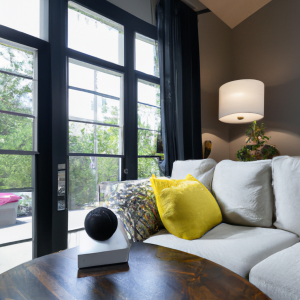Are you tired of being disturbed by outside noise while enjoying your favorite movies or music in your media room? Look no further! In this article, we will guide you through the technical world of soundproofing techniques for media rooms.
From understanding acoustics and noise control to sealing gaps and cracks, using soundproofing materials, and installing soundproof doors and windows, we have got you covered.
Say goodbye to unwanted noise and create a space that truly belongs to you.

Key Takeaways
- Acoustics and noise control are crucial for soundproofing media rooms.
- Sealing gaps and cracks is important to prevent sound leakage in media rooms.
- Using soundproofing materials like acoustic panels, foam, and curtains can reduce noise transmission.
- Installing soundproof doors and windows, as well as soundproofing walls, ceilings, and floors, enhances the overall soundproofing of the room.
Understanding Acoustics and Noise Control
If you want to create a truly soundproof media room, you need to understand acoustics and how to control noise. This is especially important for open floor plans, where sound can easily travel from one room to another.
To achieve a quiet home office environment, you must employ soundproofing techniques that effectively minimize noise transmission.
One of the primary considerations when soundproofing a media room is the materials used for the walls, ceilings, and floors. Sound-absorbing materials such as acoustic panels and insulation can significantly reduce sound transmission by absorbing and dissipating sound waves. Additionally, installing mass-loaded vinyl or soundproof drywall can further enhance soundproofing capabilities.
Properly sealing all gaps and cracks in the room is another crucial step in controlling noise. Any small openings can allow sound to leak into or out of the room, compromising the soundproofing efforts. Weatherstripping, acoustic caulk, and door sweeps can be used to seal gaps around windows, doors, and electrical outlets.
Incorporating soundproofing curtains or blinds can also help in reducing noise. These specially designed window treatments are made with sound-absorbing materials and can effectively block external noise from entering the room.
By understanding acoustics and implementing soundproofing techniques for open floor plans, you can create a quiet home office environment that allows for optimal media enjoyment without disturbing others.
Sealing Gaps and Cracks for Soundproofing
To improve the soundproofing in your media room, make sure to seal any gaps or cracks you find. Properly sealing these openings is essential for preventing sound leakage and maximizing the effectiveness of your soundproofing efforts.
When it comes to soundproofing techniques for floors, one effective method is to use acoustical caulk to seal the gaps between the floorboards or tiles. This will help prevent sound waves from traveling through the floor and into other areas of the house. Additionally, you can install heavy carpets or rugs with thick padding to further absorb sound vibrations.
Another important aspect to consider is soundproofing techniques for ventilation systems. Air vents and ductwork can be major sources of noise infiltration in a media room. To address this, you can use soundproofing insulation around the ducts to reduce noise transmission. Additionally, installing sound baffles or silencers in the ventilation system can help minimize noise from entering the room.
By sealing gaps and cracks in your media room, as well as implementing soundproofing techniques for floors and ventilation systems, you can create a more immersive and enjoyable audio experience. These techniques will not only reduce unwanted noise from entering the room but also enhance the overall sound quality within the space.
Using Soundproofing Materials
Using soundproofing materials such as acoustic panels and foam can significantly reduce noise transmission in your space. Soundproofing curtains are an excellent addition to your media room, as they are designed to absorb and block sound waves. These curtains are made with heavy and dense materials that effectively prevent sound from entering or leaving the room. They can be easily installed on windows and doors, providing an effective barrier against external noise.
Another important aspect of soundproofing your media room is the flooring. Soundproofing flooring materials are designed to reduce impact noise, such as footsteps or furniture movement. These materials, like acoustic underlayments or soundproofing mats, are installed beneath your flooring to absorb and dampen vibrations. They effectively minimize the transfer of sound through the floor, ensuring a quieter and more enjoyable media experience.
When selecting soundproofing materials for your media room, it is important to consider the specific needs of your space. Different materials have different soundproofing capabilities, so it is important to choose the right ones for your desired level of noise reduction. Additionally, proper installation and placement of these materials are crucial to achieve optimal soundproofing results.
By incorporating soundproofing curtains and flooring into your media room, you can create a space that provides excellent sound isolation and enhances your overall media experience.
Installing Soundproof Doors and Windows
When installing soundproof doors and windows in your space, it is important to choose materials that effectively block out external noise. Soundproof doors are typically made with solid cores and weatherstripping to minimize sound transmission. They are also designed with seals and gaskets to create an airtight closure, preventing any sound leakage.
Windows, on the other hand, can be soundproofed by using double or triple pane glass with an air gap in between. This construction helps to reduce noise transmission by creating a barrier that absorbs and reflects sound waves.
To further enhance the soundproofing of your media room, consider using soundproofing curtains and acoustic panels. Soundproofing curtains are made with heavy, dense materials that absorb sound and prevent it from entering or leaving the room. These curtains can be installed over windows and doors, providing an additional layer of sound insulation.
Acoustic panels are another effective tool for reducing echo and improving sound quality in your media room. These panels are designed to absorb sound waves, preventing them from bouncing off the walls and creating echoes. They can be strategically placed on the walls and ceiling of your media room to enhance the acoustics and create a more immersive audio experience.
By incorporating soundproof doors and windows, as well as soundproofing curtains and acoustic panels, you can create a space that is truly isolated from external noise and optimized for audio enjoyment.
Soundproofing Walls and Ceilings
For optimal sound insulation, consider adding additional layers of insulation to the walls and ceilings of your space. By doing so, you can greatly reduce the amount of noise that enters or leaves your media room.
Start by installing soundproofing materials such as acoustic panels or foam on the walls. These materials are designed to absorb sound waves and prevent them from bouncing around the room. Additionally, you can add a layer of mass loaded vinyl, a dense material that blocks sound transmission, to further enhance the soundproofing capabilities of your walls.
To soundproof the ceiling, you can install a suspended ceiling system with soundproof tiles. These tiles are made of materials that absorb sound and prevent it from traveling through the ceiling. Another option is to use soundproofing insulation between the ceiling joists. This insulation is designed to absorb sound vibrations and reduce noise transmission.
In addition to soundproofing the walls and ceilings, you should also consider soundproofing the floors. This can be done by using thick carpets or rugs to absorb sound vibrations. You can also install soundproofing underlayments beneath the flooring to further enhance the sound insulation.
To maximize the soundproofing capabilities of your media room, consider using soundproofing curtains. These curtains are made of heavy, dense materials that block sound from entering or leaving the room. They can be installed over windows or used as room dividers to create separate soundproof areas within the space.
By following these soundproofing techniques for your media room, you can create a quiet and immersive environment that is perfect for enjoying movies, music, or any other form of media.
Frequently Asked Questions
How much does it cost to soundproof a media room?
To soundproof a media room, the cost breakdown depends on various factors. DIY options are available to cut down expenses, but professional installation is recommended for optimal results.
Can soundproofing completely eliminate all external noise?
Soundproofing techniques have limitations and cannot completely eliminate all external noise. However, there are alternatives like double-glazed windows, acoustic panels, and door sweeps that can significantly reduce noise transmission and improve the soundproofing of a media room.
Is it necessary to hire a professional to install soundproof materials?
To achieve the best soundproofing results, it is recommended to hire a professional for installing soundproof materials. They have the expertise to properly assess your space and choose the most effective techniques. DIY soundproofing techniques may not provide the same level of precision and may result in subpar results. Hiring a professional ensures that the job is done correctly, maximizing the benefits of soundproofing for your media room.
How long does it take to complete a soundproofing project for a media room?
On average, the soundproofing process for a media room takes around 2 to 4 weeks. This includes the installation of soundproof materials, sealing gaps, and testing the effectiveness of the soundproofing measures.
Can soundproofing affect the aesthetics of the media room?
Soundproofing techniques can significantly impact the aesthetics of your media room’s interior design. By incorporating sound insulation materials and strategic placement, you can achieve both optimal soundproofing and maintain the desired room aesthetics.
Conclusion
To conclude, soundproofing techniques for media rooms are crucial in ensuring optimal sound quality and minimizing noise disturbance.
By understanding acoustics and noise control principles, sealing gaps and cracks, using soundproofing materials, and installing soundproof doors and windows, you can create a space that offers superior sound isolation.
Additionally, soundproofing walls and ceilings further enhance the effectiveness of the media room.
By implementing these techniques, you can enjoy an immersive audio experience without any interruptions or distractions.


